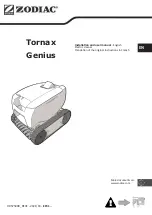
Page 10
ENGLISH
Jandy® Legacy™ Model LRZM Pool/Spa Heater by Zodiac®
|
Installation and Operation Manual
2.3.3 Flooring
The heater must be installed on a
level
surface
of noncombustible construction or on fire-resistant
slabs or arches. Noncombustible flooring is defined
as flooring material and surface finish not capable of
being ignited and burning and with no combustible
materials against the underside. Acceptable materials
are those consisting entirely of a combination of steel,
iron, brick, tile, concrete, slate, glass or plaster.
Do not
install the heater directly on a combustible wood or
carpet floor without placing a noncombustible platform
between the floor and the heater.
The heater can be installed on a combustible
floor if a noncombustible base assembly, available
from Zodiac Pool Systems, Inc. is used. See the
heater rating plate or the Parts List (Section 11) of this
manual for the appropriate base part number.
Heaters
must never be installed directly on carpeting.
As an alternative to the Jandy noncombustible
base plate, in the United States, the National Fuel Gas
Code (NFPA 54 / ANSI Z223.1), and in Canada, the
Natural Gas and Propane Installation Code (CAN/
CSA-B149.1), allow a heater to be placed on a
combustible surface when there is a platform under
the heater made of hollow masonry no less than four
(4) inches (102 millimeters [mm]) thick, covered
with sheet metal at least 24 gauge thick and extend-
ing beyond the full width and depth of the heater by
at least six (6) inches (153 mm) in all directions. The
masonry must be laid with ends unsealed, and joints
matched to provide free circulation of air from side to
side through the masonry, see Figure 2. If the heater
is installed in a carpeted alcove, the entire floor of the
alcove must be covered by a noncombustible panel.
2.3.4 outdoor installation
Legacy heaters can be installed in the low-profile
top configuration as received from the factory, or with
an optional high wind vent cap.
Locate the heater in an
open, unroofed area
. Do
not install the heater under a deck.
Do not locate the heater below or adjacent to
any doors, glass openings, louvers, grills, etc., which
connect in any way with an inhabited area of a build-
ing, even though the access might be through another
structure (e.g., a garage or utility room). In the United
States there must be a minimum of four (4) feet (1.22
m) horizontally
or
four (4) feet (1.22 m) vertically
between the heater exhaust point and any door, glass
opening, or gravity inlet to a building. In Canada, the
heater must be installed so that the exhaust point of
the heater is at least 10 feet (3.0 m) from any building
opening. See Figure 3.
table 2. Minimum Heater clearances From combustible Surfaces
table 2. dégagements Minimaux à assurer entre les Parois de
L'appareil et les constructions combustibles
Note: Clearances listed in Table 2 are
manufacturer's tested values. These are
given as minimum values. Where local
and national codes apply, and values
are different than those listed in Table
2, use the greater value to ensure safe
operation.
* In Canada - 24 in (61cm)
Figure 2. Noncombustible Platform
Notes:
1. Blocks must provide a solid base and be braced so they
cannot slip out of place.
2. Air openings in blocks must be arranged to provide unre-
stricted opening through entire width or length of base.
3. Sheet metal must be at least 24 ga. and extend 6" beyond
the heater jacket on all sides.
SIDE OF
HEATER
INDOOR (OUTDOOR
SHELTER) INSTALLATION
OUTDOOR INSTALLATION
INCHES
CENTIMETERS
INCHES
CENTIMETERS
BLANK
8
20
8
20
REAR
6
15
6
15
PIPING
14
35.6
14
35.6
TOP
44
112
OPEN UNROOFED AREA
FRONT
18*
45.7*
18*
45.7*
Sheet Metal Min.
Thickness 24 Ga
Hollow Concrete Block
Platform (In Canada - Two
continuous courses of
90mm (4 in.) thick hollow
masonry units.)
Содержание Jandy Legacy LRZ Millivolt
Страница 2: ......











































